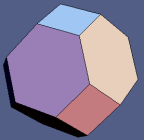Since about 1970, soccer balls have been stitched or glued together from 32 patches of material—12 of them five-sided and 20 of them six-sided. These patches are arranged so that each pentagon is surrounded by hexagons. Traditionally, the pentagons are colored black and the hexagons white.



This soccer ball is modeled on a geometric shape called a truncated icosahedron, which has 60 vertices. Its polygonal faces, however, are curved rather than flat so that the ball is roughly spherical.
Soccer ball designs have varied over the years, depending on the materials and technology available. In a break with recent tradition, the official ball being used in the 2006 World Cup is made from 14 curved panels.
In abstract (graph theory) terms, you can think of this new soccer ball design as a truncated octahedron, a form made up of eight hexagonal faces and six square faces.
Mathematics, however, suggests that the older, 32-panel design can itself be modified in various ways to yield a variety of new patterns for spherical and even doughnut-shaped soccer balls.
“To a mathematician, a soccer ball is an intriguing puzzle,” mathematician Dieter Kotschick of the University of Munich writes in the July-August American Scientist.
“Why does it look the way it does?” he asks. “Are there other ways of putting it together? Could the pentagons and hexagons be arranged differently? Could other polygons be used instead of pentagons and hexagons?”
Kotschick notes that, from a graph theory viewpoint, the standard soccer ball meets three important requirements.
(1) It is a polyhedron the consists of only pentagons and hexagons.
(2) The sides of each pentagon meet only hexagons.
(3) The sides of each hexagon alternately meet pentagons and hexagons.
If you require that there are exactly three faces meeting at each vertex, then the pattern must consist of 12 pentagons and 20 hexagons. If you lift this requirement, many other designs become possible.
Kotschick shows that it’s possible to create new soccer balls by using a mathematical construction called a branched covering.
Imagine a soccer ball’s 32-polygon pattern superimposed on Earth’s surface, with one vertex at the South Pole and another vertex at the North Pole. Trace a route from one pole to the other along the pattern’s edges. Straighten the route out into a meridian, distorting the pattern in the meridian’s neighborhood.
Then, slice Earth open along the meridian, and, holding the poles fixed, shrink the surface until it covers exactly half the sphere (say the Western hemisphere). Make a copy of this shrunken surface, or coat, and fill in the missing Eastern hemisphere. Stitch the two coats together. The result is a new soccer ball with twice as many pentagons and hexagons as before.
“The reason is that at each of the two seams running between the North and South Poles, the two sides of the seam are indistinguishable from the two sides of the cut we made in our original soccer ball,” Kotschick says. “Therefore, the two pieces fit together perfectly.”
This particular new soccer ball is called a two-fold branched covering of the original one, and the poles are called branch points.
You can use this method to create infinitely many different soccer ball designs. For example, eight copies of the sliced-open coat of the standard soccer ball can be sewn together to produce a ball with 96 pentagons and 160 hexagons.
It’s even possible to transform spherical soccer balls into doughnut-shaped (toroidal) forms, all with distorted versions of the familiar hexagon-pentagon pattern!
Michael Trott of Wolfram Research, who created many of the illustrations for Kotschick’s article, has animations of various soccer ball transformations at http://www.mathematicaguidebooks.org/soccer/.








